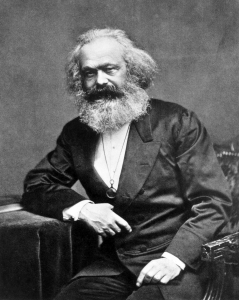Cooking the Books II: Consumption – not the driver
Consumption – not the driver
Interviewed on the Andrew Marr Show on 14 June, the Chancellor Rishi Sunak stated that

the economy was ‘driven by consumption’. It is understandable why he might think this since consumption (consumer spending) accounts for some two-thirds of GDP. But it does not follow that it is therefore this that drives the economy. In fact, it isn’t.
Apologists for the system claim that under capitalism ‘the consumer is king’; that, in other words, production is carried on – even initiated – in response to what consumers want as indicated by what they are prepared to pay for and do pay for. But this does not explain how consumers come to have money to spend in the first place.
Most consumers are wage and salary earners who get their spending money from the sale of their capacity to work at a particular job, their labour-power, to an employer. So, where do employers get the money to pay them from? It’s a part of the capital they must have to start up a business and keep it going. Marx divided the capital of a business into constant capital (plant, machinery, raw materials, power, etc) and variable capital (the money to pay the wages of the productive workers it employs).
Under capitalism production is initiated by capitalist firms seeking to expand their capital by making and accumulating profits. It goes like this. Capitalists invest in production, including hiring workers; workers exercise and use up their labour power to produce new value, including the value of their labour power; capitalists pay workers as wages the value of their labour power; workers spend their wages on buying what is needed (food, housing, clothes, entertainment, holidays, etc) to recreate their labour power to replace what they used when they worked; capitalists buy the renewed labour power; and so the circuit recommences.
Marx put it this way:
‘From the point of view of society, then, the working class, even when it stands outside the direct labour process, is just as much an appendage of capital as the lifeless instruments of labour are. Even its individual consumption is, within certain limits, a mere aspect of the process of capital’s reproduction … Individual consumption provides, on the one hand, the means for the workers’ maintenance and reproduction; on the other hand, by the constant annihilation of the means of subsistence, it provides for their continued re-appearance on the labour market’ (Capital, Volume 1, chapter 23. Penguin edition p. 719).
What this means is that what workers buy to consume is the reproduction of what variable capital is invested in. Capitalist apologists speak unashamedly of workers as ‘human capital’. Some Marxists describe workers’ consumption as variable capital. This is not strictly true (it’s only that both have the same value) but it gets over the point that workers’ consumption is a part, not the initiator, of the circuit capital goes through to increase its value.
What drives the economy is business investment for profit. This depends on the prospects for profit-making and goes up or down depending on whether these are good or bad. Less business investment means fewer workers employed and so less consumption; more business investment means more consumption. So, far from consumption driving the economy, it’s the other way round. Consumption is the tail not the dog.
